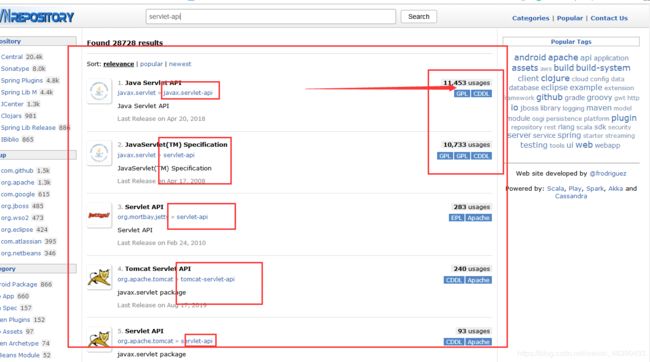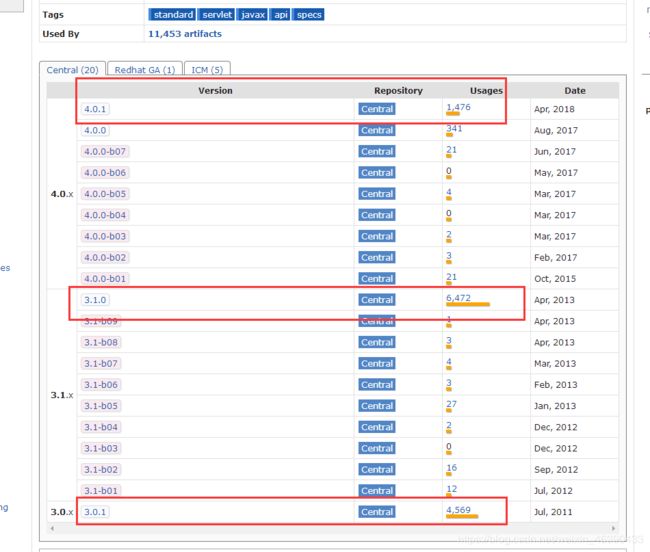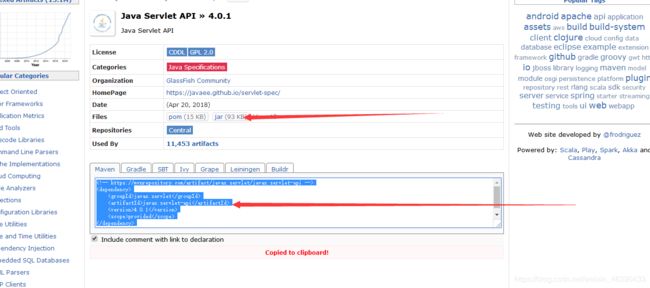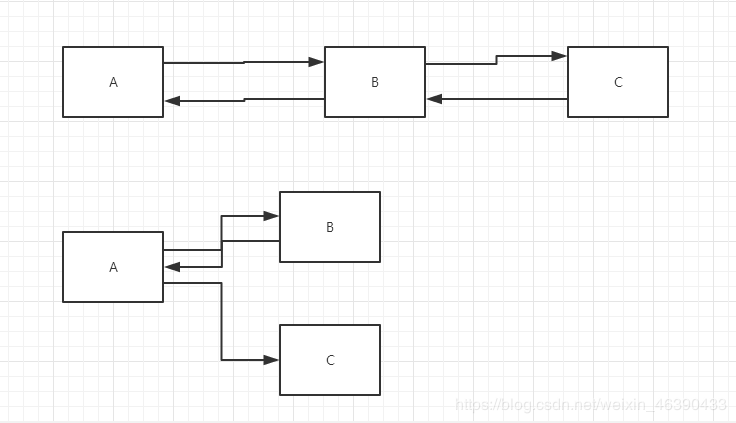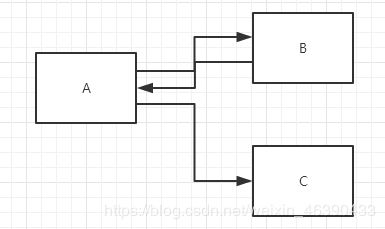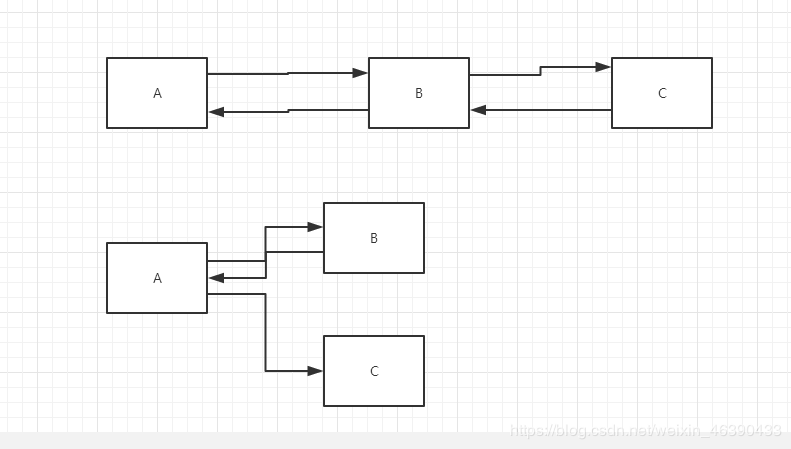Java Web学习笔记(B站 狂神说Java)
狂神老师的B站地址:https://space.bilibili.com/95256449
小伙伴们快去三连
说明:本文是搬运狂神老师javaWeb课程的课堂笔记,老师之前的博客服务器到期后访问不了,但是微信公众号(微信搜“狂神说”)在更新不过好像没上传JavaWeb的笔记,我就边学边搬运笔记,一方面记录自己的学习进度,同时也推荐大家去看狂神老师的教学视频。
JavaWeb
Java Web
1、基本概念
1.1、前言
web开发:
- web,网页的意思 , www.baidu.com
- 静态web
- html,css
- 提供给所有人看的数据始终不会发生变化!
- 动态web
- 淘宝,几乎是所有的网站;
- 提供给所有人看的数据始终会发生变化,每个人在不同的时间,不同的地点看到的信息各不相同!
- 技术栈:Servlet/JSP,ASP,PHP
在Java中,动态web资源开发的技术统称为JavaWeb;
1.2、web应用程序
web应用程序:可以提供浏览器访问的程序;
- a.html、b.html…多个web资源,这些web资源可以被外界访问,对外界提供服务;
- 你们能访问到的任何一个页面或者资源,都存在于这个世界的某一个角落的计算机上。
- URL
- 这个统一的web资源会被放在同一个文件夹下,web应用程序–>Tomcat:服务器
- 一个web应用由多部分组成 (静态web,动态web)
- html,css,js
- jsp,servlet
- Java程序
- jar包
- 配置文件 (Properties)
web应用程序编写完毕后,若想提供给外界访问:需要一个服务器来统一管理;
1.3、静态web
- *.htm, *.html,这些都是网页的后缀,如果服务器上一直存在这些东西,我们就可以直接进行读取。通络;

- 静态web存在的缺点
- Web页面无法动态更新,所有用户看到都是同一个页面
- 轮播图,点击特效:伪动态
- JavaScript [实际开发中,它用的最多]
- VBScript
- 它无法和数据库交互(数据无法持久化,用户无法交互)
- Web页面无法动态更新,所有用户看到都是同一个页面
1.4、动态web
页面会动态展示: “Web的页面展示的效果因人而异”;
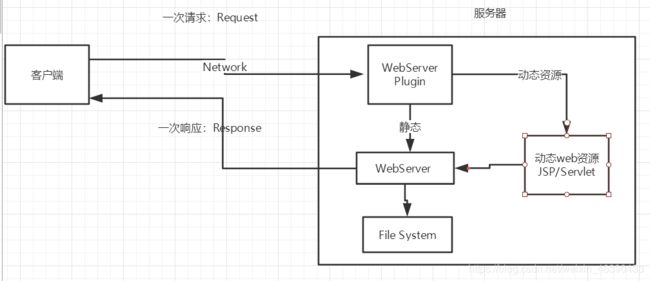
缺点:
- 加入服务器的动态web资源出现了错误,我们需要重新编写我们的后台程序,重新发布;
- 停机维护
优点:
2、web服务器
2.1、技术讲解
ASP:
-
微软:国内最早流行的就是ASP;
-
在HTML中嵌入了VB的脚本, ASP + COM;
-
在ASP开发中,基本一个页面都有几千行的业务代码,页面极其换乱
-
维护成本高!
-
C#
-
IIS
<h1> <h1><h1> <h1> <h1> <h1> <h1> <% System.out.println("hello") %> <h1> <h1> <h1><h1> <h1>
php:
- PHP开发速度很快,功能很强大,跨平台,代码很简单 (70% , WP)
- 无法承载大访问量的情况(局限性)
**JSP/Servlet : **
B/S:浏览和服务器
C/S: 客户端和服务器
- sun公司主推的B/S架构
- 基于Java语言的 (所有的大公司,或者一些开源的组件,都是用Java写的)
- 可以承载三高问题带来的影响;
- 语法像ASP , ASP–>JSP , 加强市场强度;
…
2.2、web服务器
服务器是一种被动的操作,用来处理用户的一些请求和给用户一些响应信息;
IIS
微软的; ASP…,Windows中自带的
Tomcat是Apache 软件基金会(Apache Software Foundation)的Jakarta 项目中的一个核心项目,最新的Servlet 和JSP 规范总是能在Tomcat 中得到体现,因为Tomcat 技术先进、性能稳定,而且免费,因而深受Java 爱好者的喜爱并得到了部分软件开发商的认可,成为目前比较流行的Web 应用服务器。
Tomcat 服务器是一个免费的开放源代码的Web 应用服务器,属于轻量级应用服务器,在中小型系统和并发访问用户不是很多的场合下被普遍使用,是开发和调试JSP 程序的首选。对于一个Java初学web的人来说,它是最佳的选择
Tomcat 实际上运行JSP 页面和Servlet。Tomcat最新版本为9.0。
…
工作3-5年之后,可以尝试手写Tomcat服务器;
下载tomcat:
- 安装 or 解压
- 了解配置文件及目录结构
- 这个东西的作用
3、Tomcat
3.1、 安装tomcat
tomcat官网:http://tomcat.apache.org/
3.2、Tomcat启动和配置
文件夹作用:
启动。关闭Tomcat
访问测试:http://localhost:8080/
可能遇到的问题:
- Java环境变量没有配置
- 闪退问题:需要配置兼容性
- 乱码问题:配置文件中设置
3.3、配置
可以配置启动的端口号
- tomcat的默认端口号为:8080
- mysql:3306
- http:80
- https:443
<Connector port="8081" protocol="HTTP/1.1"
connectionTimeout="20000"
redirectPort="8443" />
可以配置主机的名称
- 默认的主机名为:localhost->127.0.0.1
- 默认网站应用存放的位置为:webapps
<Host name="www.qinjiang.com" appBase="webapps"
unpackWARs="true" autoDeploy="true">
高难度面试题:
请你谈谈网站是如何进行访问的!
-
输入一个域名;回车
-
检查本机的 C:\Windows\System32\drivers\etc\hosts配置文件下有没有这个域名映射;
-
有:直接返回对应的ip地址,这个地址中,有我们需要访问的web程序,可以直接访问
127.0.0.1 www.qinjiang.com -
没有:去DNS服务器找,找到的话就返回,找不到就返回找不到;
-
-
可以配置一下环境变量(可选性)
3.4、发布一个web网站
不会就先模仿
- 将自己写的网站,放到服务器(Tomcat)中指定的web应用的文件夹(webapps)下,就可以访问了
网站应该有的结构
--webapps :Tomcat服务器的web目录
-ROOT
-kuangstudy :网站的目录名
- WEB-INF
-classes : java程序
-lib:web应用所依赖的jar包
-web.xml :网站配置文件
- index.html 默认的首页
- static
-css
-style.css
-js
-img
-.....
HTTP协议 : 面试
Maven:构建工具
- Maven安装包
Servlet 入门
- HelloWorld!
- Servlet配置
- 原理
4、Http
4.1、什么是HTTP
HTTP(超文本传输协议)是一个简单的请求-响应协议,它通常运行在TCP之上。
- 文本:html,字符串,~ ….
- 超文本:图片,音乐,视频,定位,地图…….
- 80
Https:安全的
- 443
4.2、两个时代
-
http1.0
- HTTP/1.0:客户端可以与web服务器连接后,只能获得一个web资源,断开连接
-
http2.0
- HTTP/1.1:客户端可以与web服务器连接后,可以获得多个web资源。‘
4.3、Http请求
- 客户端—发请求(Request)—服务器
百度:
Request URL:https://www.baidu.com/ 请求地址
Request Method:GET get方法/post方法
Status Code:200 OK 状态码:200
Remote(远程) Address:14.215.177.39:443
Accept:text/html
Accept-Encoding:gzip, deflate, br
Accept-Language:zh-CN,zh;q=0.9 语言
Cache-Control:max-age=0
Connection:keep-alive
1、请求行
- 请求行中的请求方式:GET
- 请求方式:Get,Post,HEAD,DELETE,PUT,TRACT…
- get:请求能够携带的参数比较少,大小有限制,会在浏览器的URL地址栏显示数据内容,不安全,但高效
- post:请求能够携带的参数没有限制,大小没有限制,不会在浏览器的URL地址栏显示数据内容,安全,但不高效。
2、消息头
Accept:告诉浏览器,它所支持的数据类型
Accept-Encoding:支持哪种编码格式 GBK UTF-8 GB2312 ISO8859-1
Accept-Language:告诉浏览器,它的语言环境
Cache-Control:缓存控制
Connection:告诉浏览器,请求完成是断开还是保持连接
HOST:主机..../.
4.4、Http响应
- 服务器—响应-----客户端
百度:
Cache-Control:private 缓存控制
Connection:Keep-Alive 连接
Content-Encoding:gzip 编码
Content-Type:text/html 类型
1.响应体
Accept:告诉浏览器,它所支持的数据类型
Accept-Encoding:支持哪种编码格式 GBK UTF-8 GB2312 ISO8859-1
Accept-Language:告诉浏览器,它的语言环境
Cache-Control:缓存控制
Connection:告诉浏览器,请求完成是断开还是保持连接
HOST:主机..../.
Refresh:告诉客户端,多久刷新一次;
Location:让网页重新定位;
2、响应状态码
200:请求响应成功 200
3xx:请求重定向
- 重定向:你重新到我给你新位置去;
4xx:找不到资源 404
- 资源不存在;
5xx:服务器代码错误 500 502:网关错误
常见面试题:
当你的浏览器中地址栏输入地址并回车的一瞬间到页面能够展示回来,经历了什么?
5 Maven
我为什么要学习这个技术?
-
在Javaweb开发中,需要使用大量的jar包,我们手动去导入;
-
如何能够让一个东西自动帮我导入和配置这个jar包。
由此,Maven诞生了!
5.1 Maven项目架构管理工具
我们目前用来就是方便导入jar包的!
Maven的核心思想:约定大于配置
- 有约束,不要去违反。
Maven会规定好你该如何去编写我们的Java代码,必须要按照这个规范来;
5.2 下载安装Maven
官网;https://maven.apache.org/
下载完成后,解压即可;
小狂神友情建议:电脑上的所有环境都放在一个文件夹下,方便管理;
5.3 配置环境变量
在我们的系统环境变量中
配置如下配置:
- M2_HOME maven目录下的bin目录
- MAVEN_HOME maven的目录
- 在系统的path中配置 %MAVEN_HOME%\bin
测试Maven是否安装成功,保证必须配置完毕!
5.4 阿里云镜像
maven文件夹下conf/settings.xml
<mirror>
<id>nexus-aliyunid>
<mirrorOf>centralmirrorOf>
<name>Nexus aliyunname>
<url>http://maven.aliyun.com/nexus/content/repositories/central/url>
mirror>
5.5 本地仓库
maven有本地仓库和远程仓库;
建立一个本地仓库(同样在settings.xml)
<localRepository>E:\maven\apache-maven-3.6.3\maven-repolocalRepository>
5.6、在IDEA中使用Maven
-
启动IDEA
-
创建一个MavenWeb项目
-
等待项目初始化完毕
-
观察maven仓库中多了什么东西?
-
IDEA中的Maven设置
注意:IDEA项目创建成功后,看一眼Maven的配置
-
到这里,Maven在IDEA中的配置和使用就OK了!
5.7、创建一个普通的Maven项目
这个只有在Web应用下才会有!
5.8 标记文件夹功能
5.9 在 IDEA中配置Tomcat
解决警告问题
必须要的配置:为什么会有这个问题:我们访问一个网站,需要指定一个文件夹名字;
5.10 pom文件
pom.xml 是Maven的核心配置文件
<project xmlns="http://maven.apache.org/POM/4.0.0" xmlns:xsi="http://www.w3.org/2001/XMLSchema-instance"
xsi:schemaLocation="http://maven.apache.org/POM/4.0.0 http://maven.apache.org/xsd/maven-4.0.0.xsd">
<modelVersion>4.0.0modelVersion>
<groupId>com.kuanggroupId>
<artifactId>javaweb-01-mavenartifactId>
<version>1.0-SNAPSHOTversion>
<packaging>warpackaging>
<properties>
<project.build.sourceEncoding>UTF-8project.build.sourceEncoding>
<maven.compiler.source>1.8maven.compiler.source>
<maven.compiler.target>1.8maven.compiler.target>
properties>
<dependencies>
<dependency>
<groupId>junitgroupId>
<artifactId>junitartifactId>
<version>4.11version>
dependency>
dependencies>
<build>
<finalName>javaweb-01-mavenfinalName>
<pluginManagement>
<plugins>
<plugin>
<artifactId>maven-clean-pluginartifactId>
<version>3.1.0version>
plugin>
<plugin>
<artifactId>maven-resources-pluginartifactId>
<version>3.0.2version>
plugin>
<plugin>
<artifactId>maven-compiler-pluginartifactId>
<version>3.8.0version>
plugin>
<plugin>
<artifactId>maven-surefire-pluginartifactId>
<version>2.22.1version>
plugin>
<plugin>
<artifactId>maven-war-pluginartifactId>
<version>3.2.2version>
plugin>
<plugin>
<artifactId>maven-install-pluginartifactId>
<version>2.5.2version>
plugin>
<plugin>
<artifactId>maven-deploy-pluginartifactId>
<version>2.8.2version>
plugin>
plugins>
pluginManagement>
build>
project>
maven由于他的约定大于配置,我们之后可以能遇到我们写的配置文件,无法被导出或者生效的问题,解决方案:
<build>
<resources>
<resource>
<directory>src/main/resourcesdirectory>
<includes>
<include>**/*.propertiesinclude>
<include>**/*.xmlinclude>
includes>
<filtering>truefiltering>
resource>
<resource>
<directory>src/main/javadirectory>
<includes>
<include>**/*.propertiesinclude>
<include>**/*.xmlinclude>
includes>
<filtering>truefiltering>
resource>
resources>
build>
5.12 IDEA操作
5.13 解决遇到的问题
-
Maven 3.6.2
解决方法:降级为3.6.1
![[外链图片转存失败,源站可能有防盗链机制,建议将图片保存下来直接上传(img-eHFd6K4o-1589699013817)(JavaWeb.assets/1567904721301.png)]](http://img.e-com-net.com/image/info8/abeb502ef72d4545aea62ec14e7b8a11.png)
-
Tomcat闪退
-
IDEA中每次都要重复配置Maven
在IDEA中的全局默认配置中去配置 -
Maven项目中Tomcat无法配置
-
maven默认web项目中的web.xml版本问题
-
替换为webapp4.0版本和tomcat一致
<web-app xmlns="http://xmlns.jcp.org/xml/ns/javaee" xmlns:xsi="http://www.w3.org/2001/XMLSchema-instance" xsi:schemaLocation="http://xmlns.jcp.org/xml/ns/javaee http://xmlns.jcp.org/xml/ns/javaee/web-app_4_0.xsd" version="4.0" metadata-complete="true"> web-app> -
Maven仓库的使用
地址:https://mvnrepository.com/
6 Servlet
6.1 Servlet简介
-
Servlet是sun公司开发的动态web的一项技术
-
Sun在API中提供一个接口叫做:Servlet,开发一个Servlet程序需要完成两个小步骤:
- 编写一个类,实现servlet接口;
- 把开发好的Java类部署到web服务器上。
把实现了Servlet接口的Java程序叫做,Servlet
6.2 编写HelloServlet程序
Serlvet接口Sun公司有两个默认的实现类:HttpServlet,GenericServlet
- 构建一个普通的Maven项目,删掉里面的src目录,在这个项目里面建立Moudel(模块),这个空的工程就是Maven主工程;
- 在Maven父子工程中
- 父项目的pom.xml中自动生成
<modules>
<module>servlet-01module>
<module>servlet-02module>
modules>
//告诉编译器,在读取主pom时,去找两个子pom
- 子项目(测试中没有自动生成)
<parent>
<artifactId>javaweb-02servletartifactId>
<groupId>cn.zafugroupId>
<version>1.0-SNAPSHOTversion>
parent>
//使子项目继承父项目的设置,避免重复导入依赖
父项目中的java,子项目可以直接使用
son extends father
- Maven环境优化
1.修改web.xml为最新(去tomca文件夹下的webapps下去取);
2.将maven结构搭建完整,,main下建java文件夹,resources文件夹

- 编写一个Servlet程序
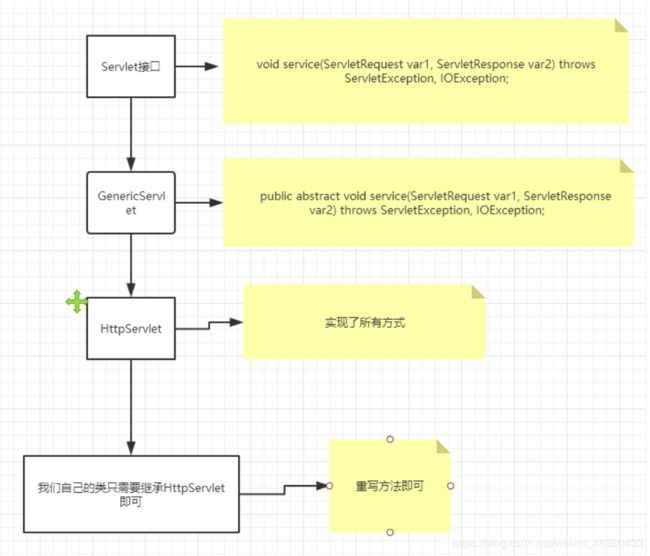
1.编写一个普通类
2.实现Servlet接口,这里我们直接继承HttpServlet(HttpServlet实现了Servlet接口)
public class HelloServlet extends HttpServlet {
//get post只是请求实现的不同方式,所有这里两个丰富可以相互调用,业务逻辑是相同的
@Override
protected void doGet(HttpServletRequest req, HttpServletResponse resp) throws ServletException, IOException {
System.out.println("doget");
PrintWriter writer = resp.getWriter();//响应流
writer.print("hello,servlet");
}
@Override
protected void doPost(HttpServletRequest req, HttpServletResponse resp) throws ServletException, IOException {
super.doPost(req, resp);
}
}
- 编写Servlet的映射
为什么需要映射?
我们写的是Java程序,但是需要通过浏览器访问,而浏览器需要连接web服务器,所以我们需要在web服务中注册我们写的Servlet,还需要给它一个浏览器能够访问的路径;
<servlet>
<servlet-name>helloservlet-name>
<servlet-class>cn.zafu.servlet.HelloServletservlet-class>
servlet>
<servlet-mapping>
<servlet-name>helloservlet-name>
<url-pattern>/hellourl-pattern>
servlet-mapping>
- 配置Tomca
注意配置项目发布路径即可。 - 启动项目
启动后通过请求路径访问程序。
— 域名/发布路径/请求路径
6.3 Servlet原理
Servlet是由Web服务器调用的,web服务器收到浏览器请求后:
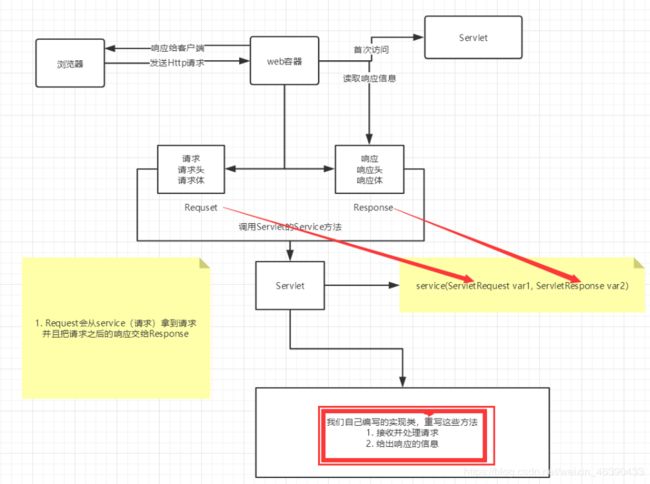
6.4 Mapping问题
-
一个Servlet可以指定一个映射路径
<servlet-mapping> <servlet-name>helloservlet-name> <url-pattern>/hellourl-pattern> servlet-mapping> -
一个Servlet可以指定多个映射路径
<servlet-mapping> <servlet-name>helloservlet-name> <url-pattern>/hellourl-pattern> servlet-mapping> <servlet-mapping> <servlet-name>helloservlet-name> <url-pattern>/hello2url-pattern> servlet-mapping> <servlet-mapping> <servlet-name>helloservlet-name> <url-pattern>/hello3url-pattern> servlet-mapping> <servlet-mapping> <servlet-name>helloservlet-name> <url-pattern>/hello4url-pattern> servlet-mapping> <servlet-mapping> <servlet-name>helloservlet-name> <url-pattern>/hello5url-pattern> servlet-mapping> -
一个Servlet可以指定通用映射路径
<servlet-mapping> <servlet-name>helloservlet-name> <url-pattern>/hello/*url-pattern> servlet-mapping> -
默认请求路径
<servlet-mapping> <servlet-name>helloservlet-name> <url-pattern>/*url-pattern> servlet-mapping> -
指定一些后缀或者前缀等等….
<servlet-mapping> <servlet-name>helloservlet-name> <url-pattern>*.cxdurl-pattern> servlet-mapping> -
优先级问题
指定了固有的映射路径优先级最高,如果找不到就会走默认的处理请求;<servlet> <servlet-name>errorservlet-name> <servlet-class>cn.zafu.servlet.ErrorServletservlet-class> servlet> <servlet-mapping> <servlet-name>errorservlet-name> <url-pattern>/*url-pattern> servlet-mapping>
6.5 ServletContext
一个web容器启动时,会为创建一个对应的ServletContext对象,它代表了当前web应用;
1、共享数据
我们在一个Servlet中通过servlerContext对象保存(set)的数据,可以在另一个servlet通过servlerContext对象get到
public class HelloServlet extends HttpServlet {
@Override
protected void doGet(HttpServletRequest req, HttpServletResponse resp) throws ServletException, IOException {
//this.getInitParameter(); 获取初始化参数
//this.getServletConfig(); 获取Servlet配置
//this.getServletContext(); 获取Servlet上下文
ServletContext servletContext = this.getServletContext();
String username = "旭";
servletContext.setAttribute("username",username);//将一个数据保存到了ServletContext中
//void setAttribute(String var1, Object var2);
}
}
public class GetServlet extends HttpServlet {
@Override
protected void doGet(HttpServletRequest req, HttpServletResponse resp) throws ServletException, IOException {
ServletContext context = this.getServletContext();
String username = (String)context.getAttribute("username");
//设置响应格式,否则中文默认GBK格式在浏览器上显示会乱码
resp.setContentType("text/html");
resp.setCharacterEncoding("utf-8");
resp.getWriter().print("名字"+username);
}
@Override
protected void doPost(HttpServletRequest req, HttpServletResponse resp) throws ServletException, IOException {
doGet(req, resp);
}
}
<servlet>
<servlet-name>helloservlet-name>
<servlet-class>cn.zafu.servlet.HelloServletservlet-class>
servlet>
<servlet-mapping>
<servlet-name>helloservlet-name>
<url-pattern>/hellourl-pattern>
servlet-mapping>
<servlet>
<servlet-name>getcservlet-name>
<servlet-class>cn.zafu.servlet.GetServletservlet-class>
servlet>
<servlet-mapping>
<servlet-name>getcservlet-name>
<url-pattern>/getcurl-pattern>
servlet-mapping>
*直接请求/getc是拿不到“username”的值的(null),需要先请求一下/hello
2、获取初始化参数
web.xml中
<context-param>
<param-name>urlparam-name>
<param-value>jdbc:mysql://localhost:3306/mybatisparam-value>
context-param>
获取
protected void doGet(HttpServletRequest req, HttpServletResponse resp) throws ServletException, IOException {
ServletContext context = this.getServletContext();
String url = context.getInitParameter("url");
resp.getWriter().print(url);
}
3、请求转发
@Override
protected void doGet(HttpServletRequest req, HttpServletResponse resp) throws ServletException, IOException {
ServletContext context = this.getServletContext();
System.out.println("进入了sd4");
RequestDispatcher requestDispatcher = context.getRequestDispatcher("/gp");//转发的请求路径
requestDispatcher.forward(req,resp);//调用forward实现请求转发
//合并写 context.getRequestDispatcher("/gp").forward(req,resp);
}
4、读取资源文件
Properties
- 在java目录下新建properties
- 在resources目录下新建properties
发现:都被打包到了同一个路径下:classes,我们俗称这个路径为classpath:
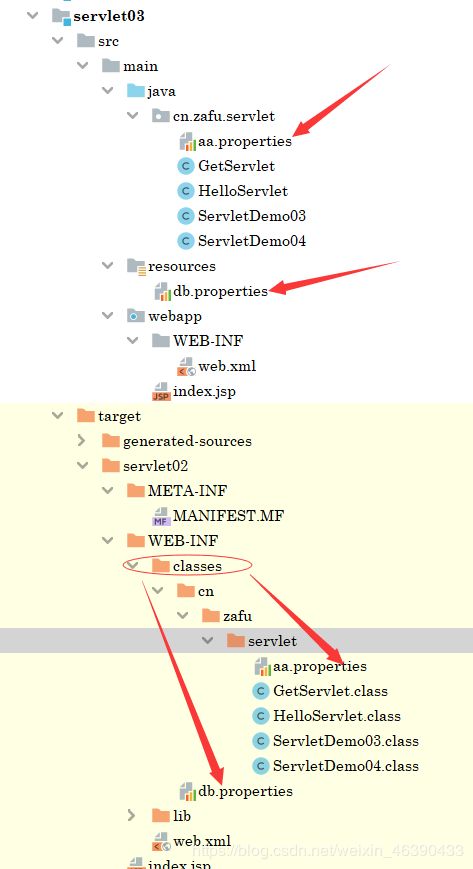
思路:需要一个文件流;
username=root12312
password=zxczxczxc
public class ServletDemo05 extends HttpServlet {
@Override
protected void doGet(HttpServletRequest req, HttpServletResponse resp) throws ServletException, IOException {
InputStream is = this.getServletContext().getResourceAsStream("/WEB-INF/classes/com/kuang/servlet/aa.properties");
Properties prop = new Properties();
prop.load(is);
String user = prop.getProperty("username");
String pwd = prop.getProperty("password");
resp.getWriter().print(user+":"+pwd);
}
@Override
protected void doPost(HttpServletRequest req, HttpServletResponse resp) throws ServletException, IOException {
doGet(req, resp);
}
}
访问测试即可ok;
6.6、HttpServletResponse
web服务器接收到客户端的http请求,针对这个请求,分别创建一个代表请求的HttpServletRequest对象,代表响应的一个HttpServletResponse;
- 如果要获取客户端请求过来的参数:找HttpServletRequest
- 如果要给客户端响应一些信息:找HttpServletResponse
1、简单分类
负责向浏览器发送数据的方法
ServletOutputStream getOutputStream() throws IOException;
PrintWriter getWriter() throws IOException;
负责向浏览器发送响应头的方法
void setCharacterEncoding(String var1);
void setContentLength(int var1);
void setContentLengthLong(long var1);
void setContentType(String var1);
void setDateHeader(String var1, long var2);
void addDateHeader(String var1, long var2);
void setHeader(String var1, String var2);
void addHeader(String var1, String var2);
void setIntHeader(String var1, int var2);
void addIntHeader(String var1, int var2);
响应的状态码
int SC_CONTINUE = 100;
int SC_SWITCHING_PROTOCOLS = 101;
int SC_OK = 200;
int SC_CREATED = 201;
int SC_ACCEPTED = 202;
int SC_NON_AUTHORITATIVE_INFORMATION = 203;
int SC_NO_CONTENT = 204;
int SC_RESET_CONTENT = 205;
int SC_PARTIAL_CONTENT = 206;
int SC_MULTIPLE_CHOICES = 300;
int SC_MOVED_PERMANENTLY = 301;
int SC_MOVED_TEMPORARILY = 302;
int SC_FOUND = 302;
int SC_SEE_OTHER = 303;
int SC_NOT_MODIFIED = 304;
int SC_USE_PROXY = 305;
int SC_TEMPORARY_REDIRECT = 307;
int SC_BAD_REQUEST = 400;
int SC_UNAUTHORIZED = 401;
int SC_PAYMENT_REQUIRED = 402;
int SC_FORBIDDEN = 403;
int SC_NOT_FOUND = 404;
int SC_METHOD_NOT_ALLOWED = 405;
int SC_NOT_ACCEPTABLE = 406;
int SC_PROXY_AUTHENTICATION_REQUIRED = 407;
int SC_REQUEST_TIMEOUT = 408;
int SC_CONFLICT = 409;
int SC_GONE = 410;
int SC_LENGTH_REQUIRED = 411;
int SC_PRECONDITION_FAILED = 412;
int SC_REQUEST_ENTITY_TOO_LARGE = 413;
int SC_REQUEST_URI_TOO_LONG = 414;
int SC_UNSUPPORTED_MEDIA_TYPE = 415;
int SC_REQUESTED_RANGE_NOT_SATISFIABLE = 416;
int SC_EXPECTATION_FAILED = 417;
int SC_INTERNAL_SERVER_ERROR = 500;
int SC_NOT_IMPLEMENTED = 501;
int SC_BAD_GATEWAY = 502;
int SC_SERVICE_UNAVAILABLE = 503;
int SC_GATEWAY_TIMEOUT = 504;
int SC_HTTP_VERSION_NOT_SUPPORTED = 505;
2、下载文件
- 向浏览器输出消息 (一直在讲,就不说了)
- 下载文件
- 要获取下载文件的路径
- 下载的文件名是啥?
- 设置想办法让浏览器能够支持下载我们需要的东西
- 获取下载文件的输入流
- 创建缓冲区
- 获取OutputStream对象
- 将FileOutputStream流写入到buffer缓冲区
- 使用OutputStream将缓冲区中的数据输出到客户端!
@Override
protected void doGet(HttpServletRequest req, HttpServletResponse resp) throws ServletException, IOException {
// 1. 要获取下载文件的路径
String realPath = "F:\\班级管理\\西开【19525】\\2、代码\\JavaWeb\\javaweb-02-servlet\\response\\target\\classes\\秦疆.png";
System.out.println("下载文件的路径:"+realPath);
// 2. 下载的文件名是啥?
String fileName = realPath.substring(realPath.lastIndexOf("\\") + 1);
// 3. 设置想办法让浏览器能够支持(Content-Disposition)下载我们需要的东西,中文文件名URLEncoder.encode编码,否则有可能乱码
resp.setHeader("Content-Disposition","attachment;filename="+URLEncoder.encode(fileName,"UTF-8"));
// 4. 获取下载文件的输入流
FileInputStream in = new FileInputStream(realPath);
// 5. 创建缓冲区
int len = 0;
byte[] buffer = new byte[1024];
// 6. 获取OutputStream对象
ServletOutputStream out = resp.getOutputStream();
// 7. 将FileOutputStream流写入到buffer缓冲区,使用OutputStream将缓冲区中的数据输出到客户端!
while ((len=in.read(buffer))>0){
out.write(buffer,0,len);
}
in.close();
out.close();
}
3、验证码功能
验证怎么来的?
- 前端实现
- 后端实现,需要用到 Java 的图片类,生产一个图片
package com.kuang.servlet;
import javax.imageio.ImageIO;
import javax.servlet.ServletException;
import javax.servlet.http.HttpServlet;
import javax.servlet.http.HttpServletRequest;
import javax.servlet.http.HttpServletResponse;
import java.awt.*;
import java.awt.image.BufferedImage;
import java.io.IOException;
import java.util.Random;
public class ImageServlet extends HttpServlet {
@Override
protected void doGet(HttpServletRequest req, HttpServletResponse resp) throws ServletException, IOException {
//如何让浏览器3秒自动刷新一次;
resp.setHeader("refresh","3");
//在内存中创建一个图片
BufferedImage image = new BufferedImage(80,20,BufferedImage.TYPE_INT_RGB);
//得到图片
Graphics2D g = (Graphics2D) image.getGraphics(); //笔
//设置图片的背景颜色
g.setColor(Color.white);
g.fillRect(0,0,80,20);
//给图片写数据
g.setColor(Color.BLUE);
g.setFont(new Font(null,Font.BOLD,20));
g.drawString(makeNum(),0,20);
//告诉浏览器,这个请求用图片的方式打开
resp.setContentType("image/jpeg");
//网站存在缓存,不让浏览器缓存
resp.setDateHeader("expires",-1);
resp.setHeader("Cache-Control","no-cache");
resp.setHeader("Pragma","no-cache");
//把图片写给浏览器
ImageIO.write(image,"jpg", resp.getOutputStream());
}
//生成随机数
private String makeNum(){
Random random = new Random();
String num = random.nextInt(9999999) + "";
StringBuffer sb = new StringBuffer();
for (int i = 0; i < 7-num.length() ; i++) {
sb.append("0");
}
num = sb.toString() + num;
return num;
}
@Override
protected void doPost(HttpServletRequest req, HttpServletResponse resp) throws ServletException, IOException {
doGet(req, resp);
}
}
4、实现重定向
B一个web资源收到客户端A请求后,B他会通知A客户端去访问另外一个web资源C,这个过程叫重定向
常见场景:
- 用户登录
void sendRedirect(String var1) throws IOException;
测试:
@Override
protected void doGet(HttpServletRequest req, HttpServletResponse resp) throws ServletException, IOException {
/*
resp.setHeader("Location","/r/img");
resp.setStatus(302);
*/
resp.sendRedirect("/r/img");//重定向
}
面试题:请你聊聊重定向和转发的区别?
相同点
- 页面都会实现跳转
不同点
- 请求转发的时候,url不会产生变化
- 重定向时候,url地址栏会发生变化;
5、简单实现登录重定向
<%--这里提交的路径,需要寻找到项目的路径--%>
<%--${pageContext.request.contextPath}代表当前的项目--%>
@Override
protected void doGet(HttpServletRequest req, HttpServletResponse resp) throws ServletException, IOException {
//处理请求
String username = req.getParameter("username");
String password = req.getParameter("password");
System.out.println(username+":"+password);
//重定向时候一定要注意,路径问题,否则404;
resp.sendRedirect("/r/success.jsp");
}
<servlet>
<servlet-name>requsetservlet-name>
<servlet-class>com.kuang.servlet.RequestTestservlet-class>
servlet>
<servlet-mapping>
<servlet-name>requsetservlet-name>
<url-pattern>/loginurl-pattern>
servlet-mapping>
<%@ page contentType="text/html;charset=UTF-8" language="java" %>
Title
Success
6.7、HttpServletRequest
HttpServletRequest代表客户端的请求,用户通过Http协议访问服务器,HTTP请求中的所有信息会被封装到HttpServletRequest,通过这个HttpServletRequest的方法,获得客户端的所有信息;
获取参数,请求转发
@Override
protected void doGet(HttpServletRequest req, HttpServletResponse resp) throws ServletException, IOException {
req.setCharacterEncoding("utf-8");
resp.setCharacterEncoding("utf-8");
String username = req.getParameter("username");
String password = req.getParameter("password");
String[] hobbys = req.getParameterValues("hobbys");
System.out.println("=============================");
//后台接收中文乱码问题
System.out.println(username);
System.out.println(password);
System.out.println(Arrays.toString(hobbys));
System.out.println("=============================");
System.out.println(req.getContextPath());
//通过请求转发
//这里的 / 代表当前的web应用
req.getRequestDispatcher("/success.jsp").forward(req,resp);
}
面试题:请你聊聊重定向和转发的区别?
相同点
- 页面都会实现跳转
不同点
- 请求转发的时候,url不会产生变化 307
- 重定向时候,url地址栏会发生变化; 302



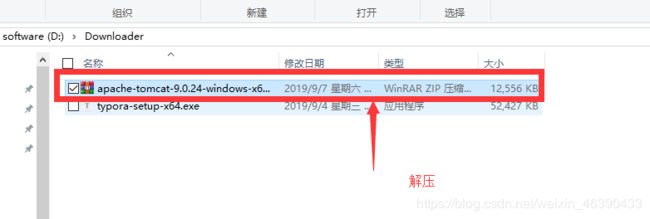


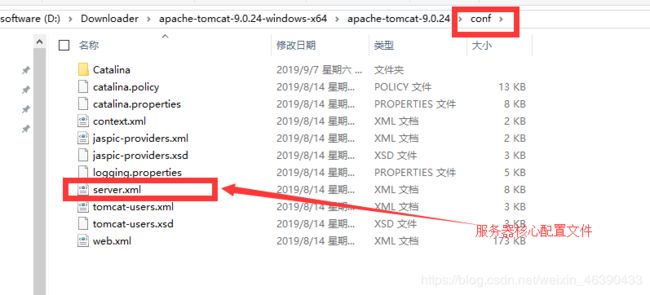








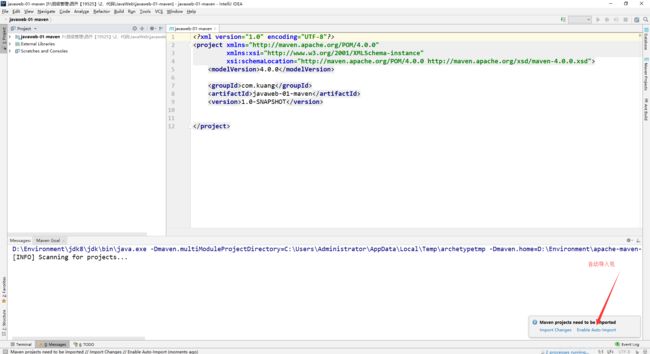

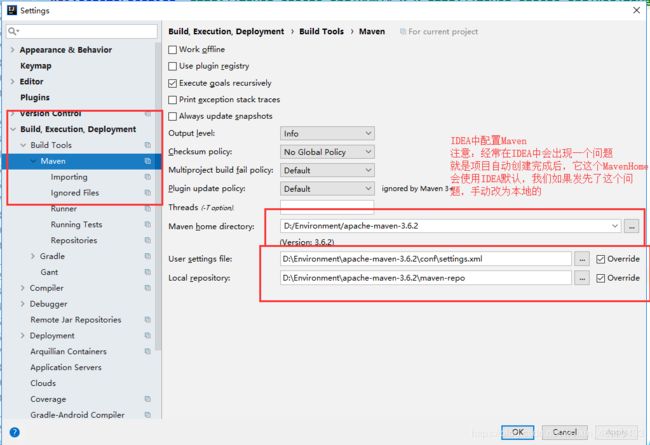

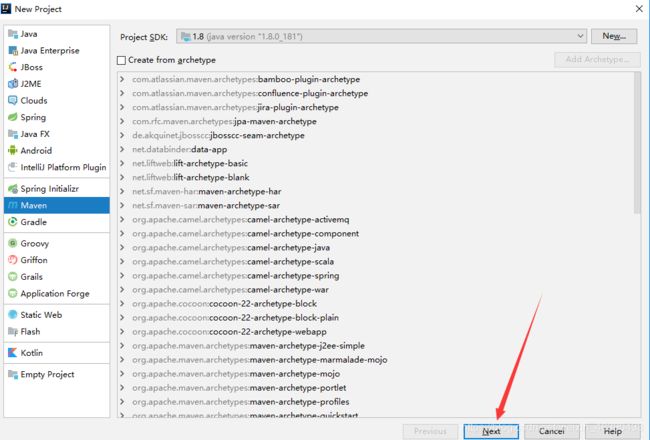



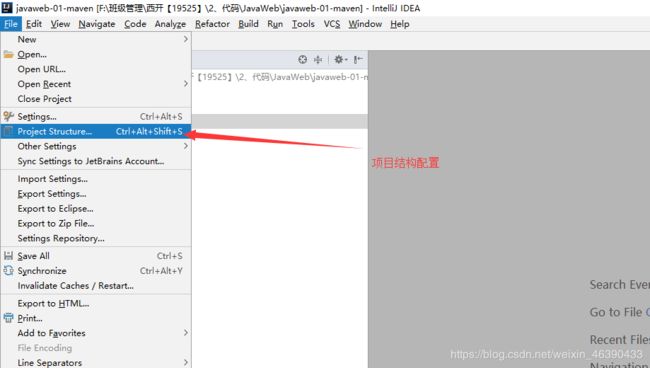
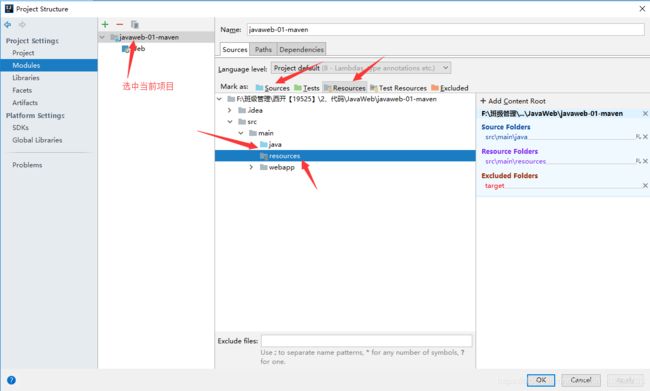



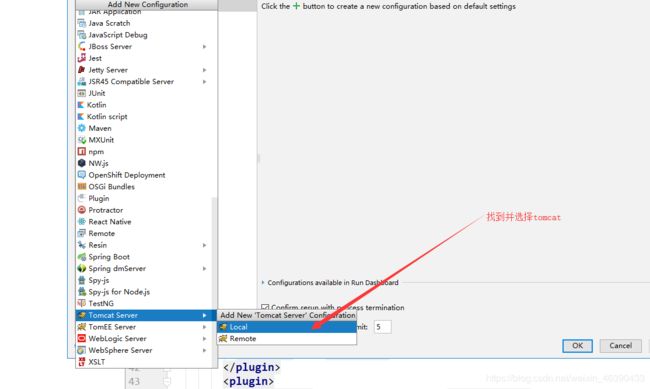
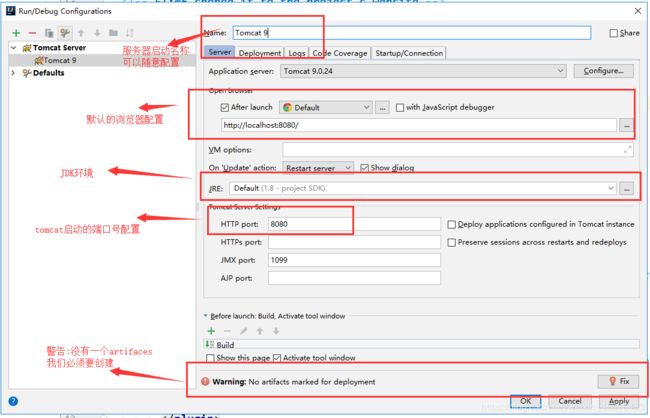
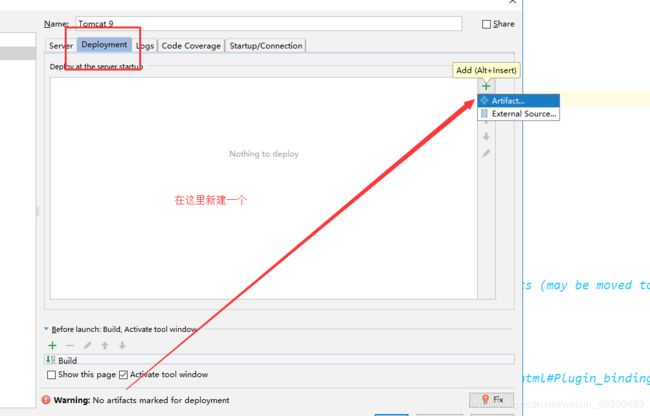


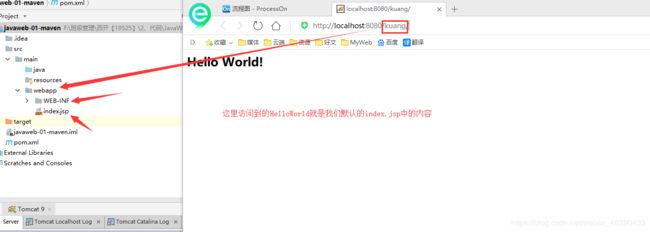
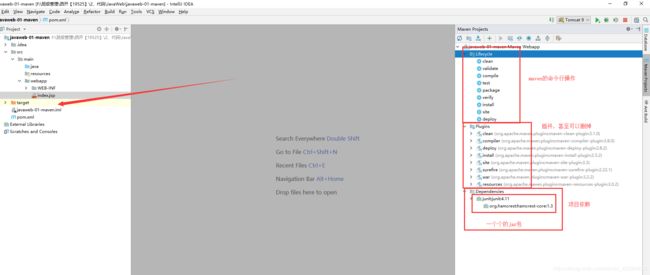
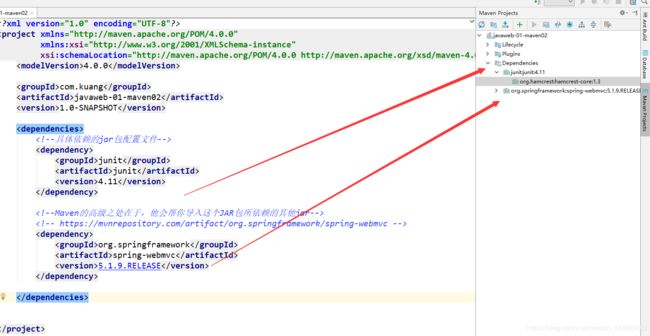

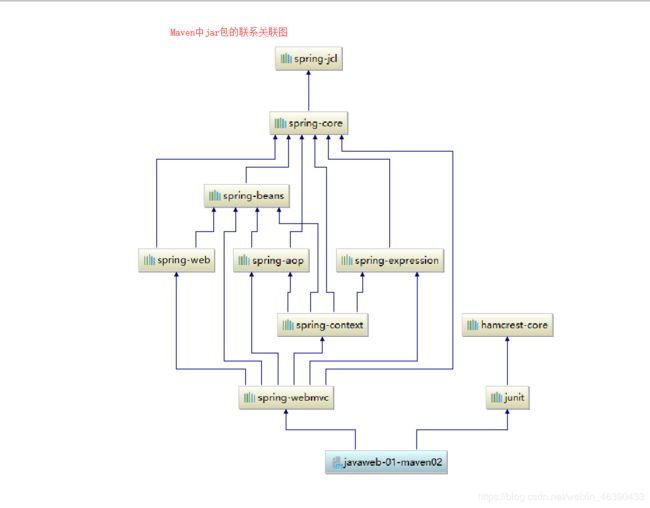
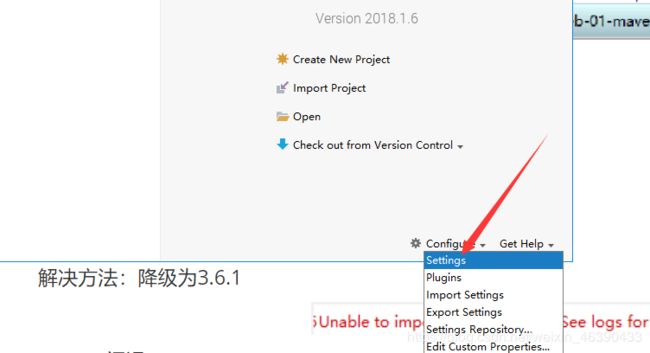
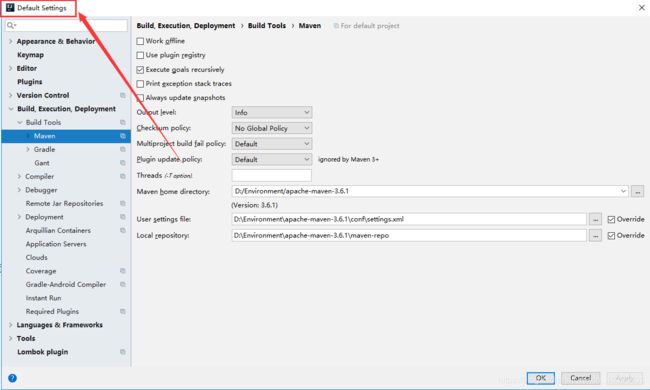
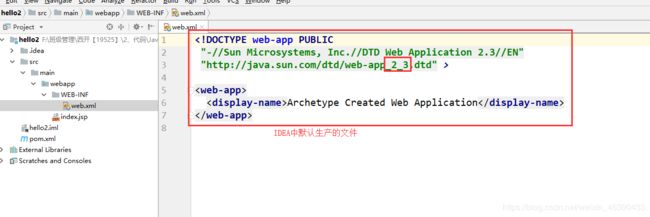
![[外链图片转存失败,源站可能有防盗链机制,建议将图片保存下来直接上传(img-amyEhndQ-1589699013819)(JavaWeb.assets/1567905870750.png)]](http://img.e-com-net.com/image/info8/5bf07174282d422ebbebd3568cfa0c26.jpg)
